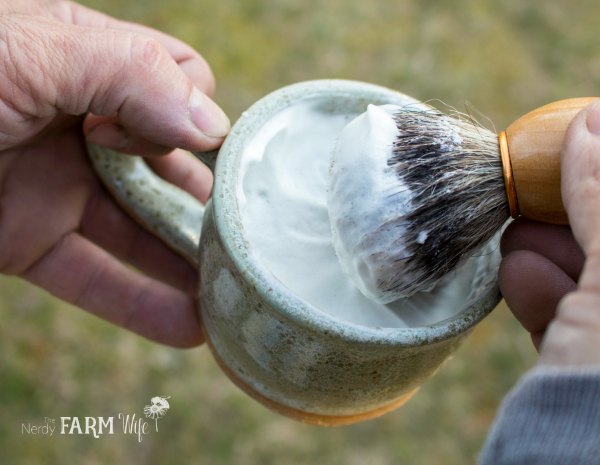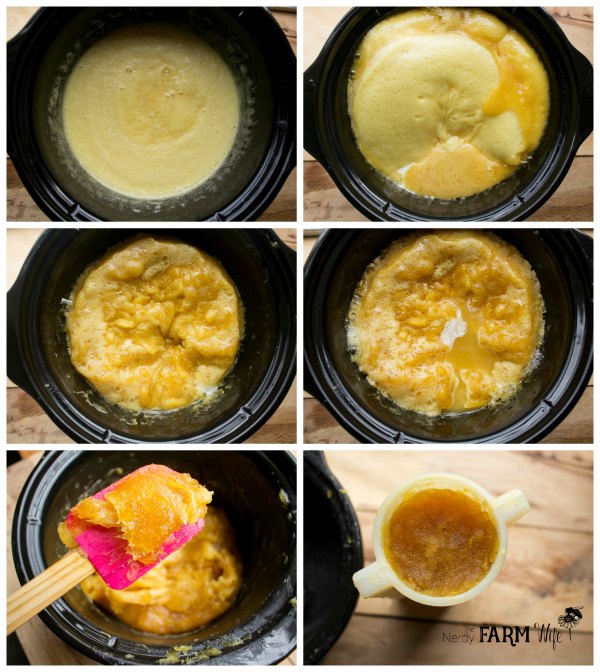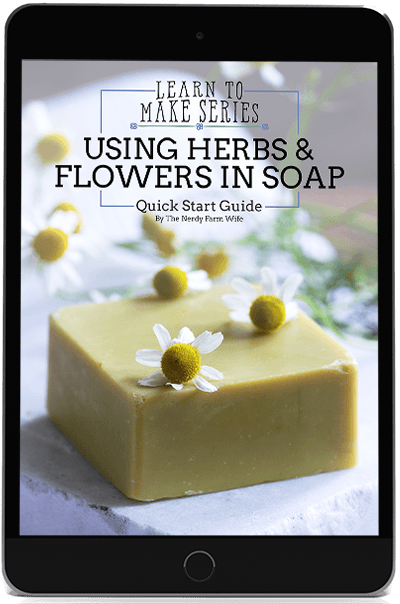Calendula Shave Soap Recipe {dual lye, palm free}

This calendula shave soap recipe was requested by newsletter subscriber Lianne, which was perfect timing since my husband also requested some new shave soap. :)
It includes both sodium hydroxide and potassium hydroxide, plus has a high amount of stearic acid in order to produce a dense lather that’s perfect for shaving.
Most shave soap recipes rely on soy wax or stearic acid flakes to meet the criteria for stearic acid amount, but I prefer making shave soaps without either of those two ingredients, so instead rely on kokum butter, which contains 56% stearic acid.
It took a lot of experimenting and failed batches to get the basic shave soap to turn out to my satisfaction (and more importantly, meet my husband’s approval too), which is why I don’t recommend changing up any of the oils and butters in this recipe, without first reading the accompanying article on how to create your own shave soap recipe.
If you’ve purchased my print book, Simple & Natural Soapmaking, then you’ll recognize that this recipe is based on the Cedarwood & Coconut Milk Shave Soap recipe on pages 123 – 125. (Don’t have my book yet? You can learn more HERE!)
Before You Begin
- Purchase both sodium hydroxide, such as Red Crown High Test Lye or ComStar Pure Lye, AND (90% purity) potassium hydroxide, such as Essential Depot or Bramble Berry brand.
- Make calendula tea by pouring 16 oz (454 g) simmering hot distilled water over a cup or so of dried calendula flowers. Steep for at least 30 minutes to an hour, strain and then cool completely in your fridge. (Add more water to the tea until it weighs 16 oz again.)
- Infuse the coconut oil with calendula flowers, following the quick infusion directions in this post on 10 Things to Make with Calendula.
- Shave soaps aren’t as complicated as they look, but you should have some prior soapmaking experience before trying this recipe.

Ingredients for Making Calendula Shave Soap Recipe {dual lye}
* For variety & enhanced lather, try replacing half of the calendula tea with coconut milk.
- 16 oz (454 g) cooled calendula tea
- 1.2 oz (34 g) sodium hydroxide
- 1.8 oz (51 g) potassium hydroxide (90% purity)
- 10.6 oz (300 g) kokum butter (60%)
- 3.5 oz (100 g) calendula infused coconut oil (20%)
- 2.6 oz (75 g) castor oil (15%)
- 0.88 oz (25 g) shea butter (5%)
- 0.5 oz (14 g) vegetable glycerin
- essential oils of choice (see below)
- shaving brush, required for proper lathering
(Etsy is a great source for handmade shaving bowls, mugs and brushes.)

Directions to Make Calendula Shave Soap Recipe
- Put on protective goggles and gloves.
- Sprinkle both types of lye into the cooled tea, one at a time; stirring until completely dissolved. Set aside.
- Melt the butters and coconut oil, then combine with the castor oil in a 4 quart slow cooker (crockpot).
- Turn the heat to low.
- Pour the lye solution into the warmed oils and start stirring, using a combination of hand stirring and an immersion blender, until light trace is reached. (About 10 minutes.)
- Cover the slow cooker and cook the soap, checking every 15 minutes, stirring if needed.
- Cook about 1 hour or until the soap is transparent and resembles glossy mashed potatoes when stirred.
- Turn off the slow cooker, remove the top and allow the soap to cool for a few minutes.
- Combine the vegetable glycerin and essential oils and stir into the cooked soap.
- Spoon and firmly press the soap into a column mold (I use THIS ONE) or individual round molds.
- Leave the soap uncovered for 24 hours or until cool.
- Remove from mold, slice into bars and cure for at least 3 weeks before using.
* My crockpot runs hot, so your cook time may vary. Allow for an extra 30 minutes to an hour cooking if needed.

Essential Oils
- Those with sensitive skin or noses may wish to leave this recipe unscented, adding the glycerin after cook time, without the essential oils.
- For a fresh touch of orange scent, try 18 grams of ten-fold (10x) orange essential oil + 12 grams grapefruit essential oil.
- Or, you may enjoy my all-time favorite shave soap essential oil blend of 5 grams cedarwood atlas + 2 grams clove + 2 grams vetiver essential oils.
- Feel free to experiment with other essential oil combinations, using my printable essential oils for soapmaking chart for reference if needed.




Amazing! I cannot wait to make this!! Thank you so much! I’ve made several recipes from your book 101 Easy Homemade Products, everything has turned out beautifully. I especially love your soap recipes, I’ve tried most of them from the book and a few from your blog. Great job ?
Hi Lianne! I’m so happy to hear that you’ve had great success with the recipes! Thanks for the kind words & support! :)
I just placed an order for soy wax and thought I’d try making a shaving soap so I’m curious about why you chose not to use it. Is it that you like kokum butter or is there something else I should know?
Hi Deeksha! Some of my readers don’t like to use soy wax because it’s highly processed, so I wanted to provide a recipe that didn’t include it. For myself, I don’t mind using soy wax sometimes if it’s a high quality, so I have more shaving recipes I’m experimenting with – some with soy wax in them. Stay tuned!
Oh was I wondering how to use dual lye :) thanks for the info.
Hi Liz! I’m so glad you found the information helpful! :)
Hello Jan ! I’d like to make this recipe following the exact same ingredients that you used, but I have one question and forgive me if it’s too obvious. I saw the image with the shaving brush and I thought that the final product would be a creamy frothy lotion. But I see now that it is in fact, a bar of soap that lathers when you add water? I’m confused please help.
Hi Rosy! Yes, the final product is a solid bar of soap. You use a shaving brush to whip up a thick dense lather on the surface of the soap. The lather is not quite the same as using shaving foam from a can, but acts more in that way than regular soap recipes do. :)
Any subs for kokoum butter? Cocoa or mix cocoa and stearic acid? How much of each %? Please and thank you never made this type of soap before.
Hi Soap Lady! You can swap out kokum butter with stearic acid or soy wax, but you’ll probably have to experiment a little to get the right amounts of other ingredients. I’ve found that shave soaps take a LOT of trial batches any
time you change up ingredients & I haven’t tried this recipe with anything else to know for sure of any exact amounts.
I wish I could give more solid numbers, but here’s a post that will give you more information to help with your experiments: :)
https://thenerdyfarmwife.com/faqs-how-to-create-your-own-shave-soap-recipe/
Thanks so much, Jan, for this recipe. It’s what I’ve been searching for…I’ll be making my first shave soap! I just ordered kokum butter. =) I’m wondering with this recipe how many round pucks this made, and the approximate weight & dimensions of each? Thanks again!!
Hi Talia! It should yield about 8 to 10 round bars of soap (a little over 2.5″ across) if you use a mold similar to the one linked at Bramble Berry. They do lose quite a bit of water weight as they cure – I just grabbed one that was several months old & it weighs 2.7 ounces. :)
Thank you! =)
Can this be made the cold processed way instead of heating it in a slow cooker? Thank you!
Hi Andrea! Shave soap has such a high amount of stearic acid in it (in this recipe from the kokum butter) which helps with hardness & overall recipe structure, that it will tend to easily seize up if made cold process. I like cold process soapmaking best myself, but in the case of shave soap, it’s much easier and less risky to work with if cooked. :)
Hi, I like your recipes, but was wondering why your shaving soaps use hot process instead of cold process. What difference does this make
Hi Llyvonne! That’s a great question! Because of the high amount of stearic acid (in this case provided by the kokum butter) in shave soaps, then the soap batter can quickly seize up and turn to soap-on-a-stick when made cold process. So while I like making cold process better than hot process most of the time, in this case, it’s easier to work with when cooked. :)
Hi, I am interested in making this shave soap. I haven’t used dual lye before but you mentioned that coconut milk can substitute half the calendula tea. My question is can I use coconut milk powder instead And how will the quantities/ingredients alter. Hope this makes sense
Regards Sandra
Hi Sandra! Yes, you can use coconut milk powder – try blending perhaps a tablespoon into the warmed oils right before adding the lye solution. You could just use all calendula tea for the liquid amount, and no other changes should be needed. :)
Hi Jan Have made the Shave soap now and was curious to know after one day would the soap still be soft?
Hi Sandra! Yes, the shave soap starts off on the soft side and will need to dry out during a few weeks of cure time. :)